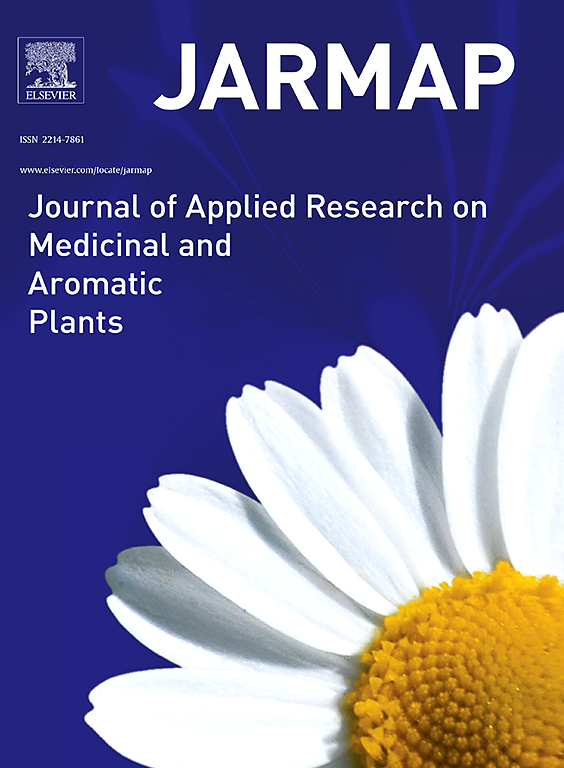Ultrasound-cellulase synergy for the extraction of total flavonoids from Astragali complanati Semen and its antioxidant properties
IF 3.6
2区 农林科学
Q1 PLANT SCIENCES
Journal of Applied Research on Medicinal and Aromatic Plants
Pub Date : 2024-10-28
DOI:10.1016/j.jarmap.2024.100597
引用次数: 0
Abstract
The present study was conducted to optimize ultrasound-cellulase synergy extraction (UCSE) process of flavonoids from Astragali complanati Semen (ACS) adopting response surface methodology (RSM). The extraction efficiency of different extraction progress by UCSE under the 240 W and 480 W were compared, and the antioxidant activities were evaluated in vitro. The effects of five independent variables (cellulase addition, liquid-solid ratio, extraction time, extraction temperature, and ultrasonic power) on the extraction efficiency were explored, and four major factors (cellulase addition, liquid-solid ratio, extraction temperature and ultrasonic power) showing great influences were chosen to study their interactions by RSM. The relationships between ultrasound power 240 W and 480 W on substrates and cellulase were further explored by scanning electron microscopy and 3,5-dinitrosalicylic acid (DNS) method, respectively. The antioxidant activities on 1,1-diphenyl-2-picryl-hydrazyl radical (DPPH) and 2,2′-azinobis-(3-ethylbenzthiazoline-6-sulphonate) radical (ABTS+) were evaluated in vitro. The optimal conditions: cellulase addition 930 U/g, liquid-solid ratio 24 mL/g, extraction time 75 min, extraction temperature 64°C and ultrasonic power 234 W, under the adjusted conditions, the extraction rate was 1.937 g/100 g ACS. Ultrasound power 240 W assisted extraction with cellulase improved the extraction efficiency of the antioxidant. From scanning electron microscopy, the substrate particles were finer and the pores were larger under the function of 240 W, and the enzyme activity test further determined that 480 W could reduce the effect of the cellulase. The UCSE extract exhibited great antioxidant activity in vitro, the IC50 of DPPH is 11.851 µg/mL, and of ABTS+ is 23.426 µg/mL.
从黄芪精中提取总黄酮及其抗氧化性的超声-纤维素酶协同作用
本研究采用响应面方法(RSM)对黄芪中黄酮类化合物的超声-纤维素酶协同萃取(UCSE)工艺进行了优化。比较了在 240 W 和 480 W 下 UCSE 不同萃取工艺的萃取效率,并对其抗氧化活性进行了体外评价。探讨了五个自变量(纤维素酶添加量、液固比、萃取时间、萃取温度和超声功率)对萃取效率的影响,并选择了影响较大的四个主要因素(纤维素酶添加量、液固比、萃取温度和超声功率),利用 RSM 研究了它们之间的相互作用。通过扫描电子显微镜和 3,5-二硝基水杨酸(DNS)法分别进一步探讨了超声功率 240 W 和 480 W 与基质和纤维素酶之间的关系。体外评估了纤维素酶对 1,1-二苯基-2-苦基肼自由基(DPPH)和 2,2′-偶氮双(3-乙基苯并噻唑啉-6-磺酸)自由基(ABTS+)的抗氧化活性。最佳条件:纤维素酶添加量 930 U/g,液固比 24 mL/g,萃取时间 75 min,萃取温度 64℃,超声功率 234 W。用纤维素酶辅助超声波功率 240 W 的萃取提高了抗氧化剂的萃取效率。从扫描电子显微镜观察,在 240 W 的作用下,基质颗粒更细,孔隙更大,酶活性测试进一步确定 480 W 可以降低纤维素酶的作用。UCSE 提取物在体外具有很强的抗氧化活性,DPPH 的 IC50 为 11.851 µg/mL,ABTS+ 的 IC50 为 23.426 µg/mL。
本文章由计算机程序翻译,如有差异,请以英文原文为准。
求助全文
约1分钟内获得全文
求助全文
来源期刊

Journal of Applied Research on Medicinal and Aromatic Plants
Pharmacology, Toxicology and Pharmaceutics-Drug Discovery
CiteScore
6.40
自引率
7.70%
发文量
80
审稿时长
41 days
期刊介绍:
JARMAP is a peer reviewed and multidisciplinary communication platform, covering all aspects of the raw material supply chain of medicinal and aromatic plants. JARMAP aims to improve production of tailor made commodities by addressing the various requirements of manufacturers of herbal medicines, herbal teas, seasoning herbs, food and feed supplements and cosmetics. JARMAP covers research on genetic resources, breeding, wild-collection, domestication, propagation, cultivation, phytopathology and plant protection, mechanization, conservation, processing, quality assurance, analytics and economics. JARMAP publishes reviews, original research articles and short communications related to research.
 求助内容:
求助内容: 应助结果提醒方式:
应助结果提醒方式:


